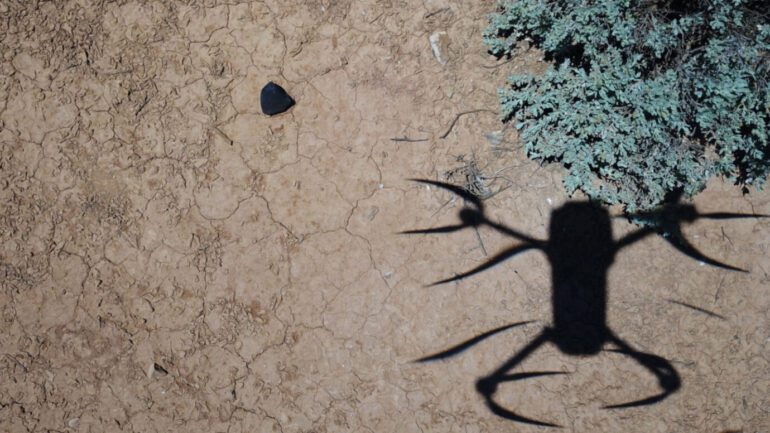TL;DR:
- Traditional meteorite hunting involves laborious manual efforts over vast landscapes.
- Scientists are now utilizing drones and machine learning to efficiently locate meteorites.
- Seamus Anderson’s team achieved success in recovering meteorites using drones.
- Drone-based searches reduce human effort from 300 days to about a dozen.
- Challenges include remote expedition logistics and fine-tuning the machine learning algorithm.
Main AI News:
In the quest to unravel the secrets of our early solar system, meteorites have long been prized treasures. Yet, the process of locating these celestial gems has been anything but streamlined, often involving painstaking hours of human effort, traversing vast landscapes while scanning the ground. However, a paradigm shift is underway as some ingenious scientists turn to the dynamic duo of drones and machine learning to dramatically enhance the efficiency of meteorite discovery.
Seamus Anderson, a distinguished planetary scientist from Curtin University in Perth, Australia, sheds light on the conventional meteorite-hunting process. A team of six individuals embarks on an expedition, covering an expansive 200,000 square meters per day. However, pinpointing the precise location of a meteorite cluster, which can span millions of square meters, proves to be an arduous task. Anderson aptly describes it as “quite slow.”
Around 2016, Anderson initiated a groundbreaking idea – employing drones to capture images of the ground in the quest for meteorites. This notion evolved into a full-fledged Ph.D. project. Fast forward to 2022, and Anderson and his team achieved a significant milestone by successfully recovering a meteorite identified through drone surveillance. Subsequently, four more meteorites were discovered at a different site, a groundbreaking achievement showcased on August 17 at a meeting of the Meteoritical Society in Los Angeles.
Drone-based searches are revolutionizing meteorite discovery, significantly reducing the human effort required. Anderson highlights the staggering transformation: “You’re going from about 300 days of human effort down to about a dozen or so.” Beyond efficiency, the work is characterized by its excitement and allure, albeit not without its challenges.
Anderson and his collaborators have deployed drones in the remote landscapes of Western Australia and South Australia, guided by networks of ground-based cameras that monitor meteoroids’ atmospheric entry. The expedition involves loading a four-wheel drive vehicle with a trove of equipment, from drones and computers to power sources, food, and camping gear. Navigating rugged, often non-existent roads on journeys that can span more than a day, punctuated by tire-popping anxieties, precedes the search.
Upon arrival at the designated site, the team deploys its primary drone, hovering at an altitude of approximately 20 meters. The drone’s camera captures ground images at one-second intervals, with data downloaded every 40 minutes when the drone lands for a battery refresh.
A single day’s flight can yield over 10,000 images, digitally divided into roughly 100 million smaller sections, each measuring 2 meters on a side. These “tiles” are processed by a machine learning algorithm trained to discern meteorites from images of real meteorites or terrestrial rocks painted black, serving as convincing proxies. The algorithm is highly proficient but not infallible, automatically discarding the majority of tiles, often more than 99 percent, devoid of meteorite-like objects. This leaves about 50,000 tiles per day for human scrutiny, a meticulous process.
While most tiles reveal non-meteorite objects like animal waste, tin cans, snakes, or slumbering kangaroos, they trigger alarms simply because the algorithm is unfamiliar with them, necessitating manual intervention to sift through the false positives.
For objects that continue to intrigue the human eye, a smaller drone is dispatched to investigate at a much lower altitude, approximately one meter above the ground. Eventually, the team conducts on-site inspections of the most promising candidates.
The researchers aspire to enhance their algorithm’s capacity to differentiate meteorites from non-relevant objects and plan to make their computer code open-source, facilitating wider utilization by fellow researchers.
Anderson’s vision extends to the icy terrain of Antarctica, a pivotal arena for meteorite investigation. However, working in this extreme environment poses an entirely new set of challenges, from safeguarding electronic equipment in frigid conditions to navigating the logistical complexities of operating in such a remote location. As Anderson aptly puts it, “Antarctica is a whole different beast.“

A machine learning algorithm, trained to identify potential meteorites in drone images, can mistake sleeping kangaroos (indicated with yellow squares) for space rocks. Researchers are working on improving the algorithm further. Source: THE DESERT FIREBALL NETWORK
Conclusion:
The integration of drones and machine learning in meteorite discovery presents a significant transformation in the market for scientific exploration tools. Efficiency gains, from reducing human effort to streamlining the search process, are poised to make meteorite hunting more accessible and fruitful. The adoption of such technology not only enhances scientific endeavors but also opens doors for innovation and potential commercial applications in the broader field of remote sensing and data collection.

